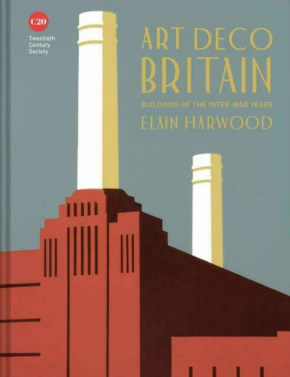Art Deco Britain: buildings of the interwar years
Art Deco Britain: buildings of the interwar years, Elain Harwood, Batsford, 2019, 272 pages, fully illustrated in colour, hardback.
The reputation of art deco has improved. A style that was often regarded as not meriting serious consideration is now recognised as interesting and worthwhile. Preserved examples have become fashionable again in places as far apart as Miami Beach, Prague and Singapore; these survivors often get listed locally and their owners upgrade services to renew viability. The rise in esteem has been a world-wide trend with the revival prompting many publications both in print and online to record the fabric.
Harwood’s book abundantly illustrates how England and Scotland are rich in such well-preserved buildings. Most of those included are listed Grade II. With some exceptions they present refurbished features that show up well in this visual and historical guide to art deco on the British mainland, plus two from Jersey (although missing out the Isle of Man’s several examples). Wales does not receive inclusion. The author’s career as a specialist in the 20th century is based on work for Historic England (formerly English Heritage), topped-up here with further Scottish expertise.
In layout the new book is similar to Harwood’s 2003 ‘England, a Guide to Post-war Listed Buildings’ on individual page openings a single-colour image of the building is accompanied on the opposite side with a short text giving the story in brief. In this way readers are introduced to the subject and presented with insights that can stimulate their own further investigations. Favourites abound, even if you can not help thinking ‘but XYZ is just round the corner and that’s great as well’.
The originality of art deco was to give the buildings of its era in the 1920s and 30s (garages, flash hotels, lidos, roadhouse pubs, blocks of upmarket flats and cinemas) an architectural expression both novel and accessible to all. Examples of art deco are widely admired and collected. In an effortless way the style crossed over into design for household wares, such as radio sets and cocktail shakers, or even bodywork for cars, buses and other classic vehicles such as the Dodge pick-up trucks. In this way it is not difficult to recreate a complete 1930s environment in your house, hotel or office. Art deco even anticipated pop art through the impact it made on mass advertising, and the media contact it established with the leisure and consumption habits of us all.
Art Deco Britain provides a further chance to re-examine the national 20th-century built heritage and to reflect on the destiny of lost examples as well as the survivors that fill these pages, practically all now enjoying statutory protection. Since so many sites have moved on from their original roles, it is worth viewing here what developers and planners have achieved up and down the country to find new uses. Basking in the light, these refurbished buildings are brilliantly portrayed in colour. The images remind us of the cult of sunbathing that arose in the same interwar years. It is ironic that the public first encountered the art-deco style in magazines, journals and newspapers through the grainy black-and-white photos of those times.
This article originally appeared as ‘Novel and accessible’ in IHBC's Context 163 (Page 58), published by The Institute of Historic Building Conservation in March 2020. It was written by Graham Tite, conservation officer.
--Institute of Historic Building Conservation
Related articles on Designing Buildings Wiki
IHBC NewsBlog
Old Sarum fire in listed (& disputed) WW1 Hangar - Wiltshire Council has sought legal advice after fire engulfed a listed First World War hangar that was embroiled in a lengthy planning dispute.
UK Antarctic Heritage Trust launches ‘Virtual Visit’ website area
The Trust calls on people to 'Immerse yourself in our heritage – Making Antarctica Accessible'
Southend Council pledge to force Kursaal owners to maintain building
The Council has pledged to use ‘every tool in the toolbox’ if urgent repairs are not carried out.
HE’s Research Magazine publishes a major study of the heritage of England’s suburbs
The article traces the long evolution of an internal programme to research 200 years of suburban growth
IHBC Context 183 Wellbeing and Heritage published
The issue explores issues at the intersection of heritage and wellbeing.
SAVE celebrates 50 years of campaigning 1975-2025
SAVE Britain’s Heritage has announced events across the country to celebrate bringing new life to remarkable buildings.
IHBC Annual School 2025 - Shrewsbury 12-14 June
Themed Heritage in Context – Value: Plan: Change, join in-person or online.
200th Anniversary Celebration of the Modern Railway Planned
The Stockton & Darlington Railway opened on September 27, 1825.
Competence Framework Launched for Sustainability in the Built Environment
The Construction Industry Council (CIC) and the Edge have jointly published the framework.
Historic England Launches Wellbeing Strategy for Heritage
Whether through visiting, volunteering, learning or creative practice, engaging with heritage can strengthen confidence, resilience, hope and social connections.
















